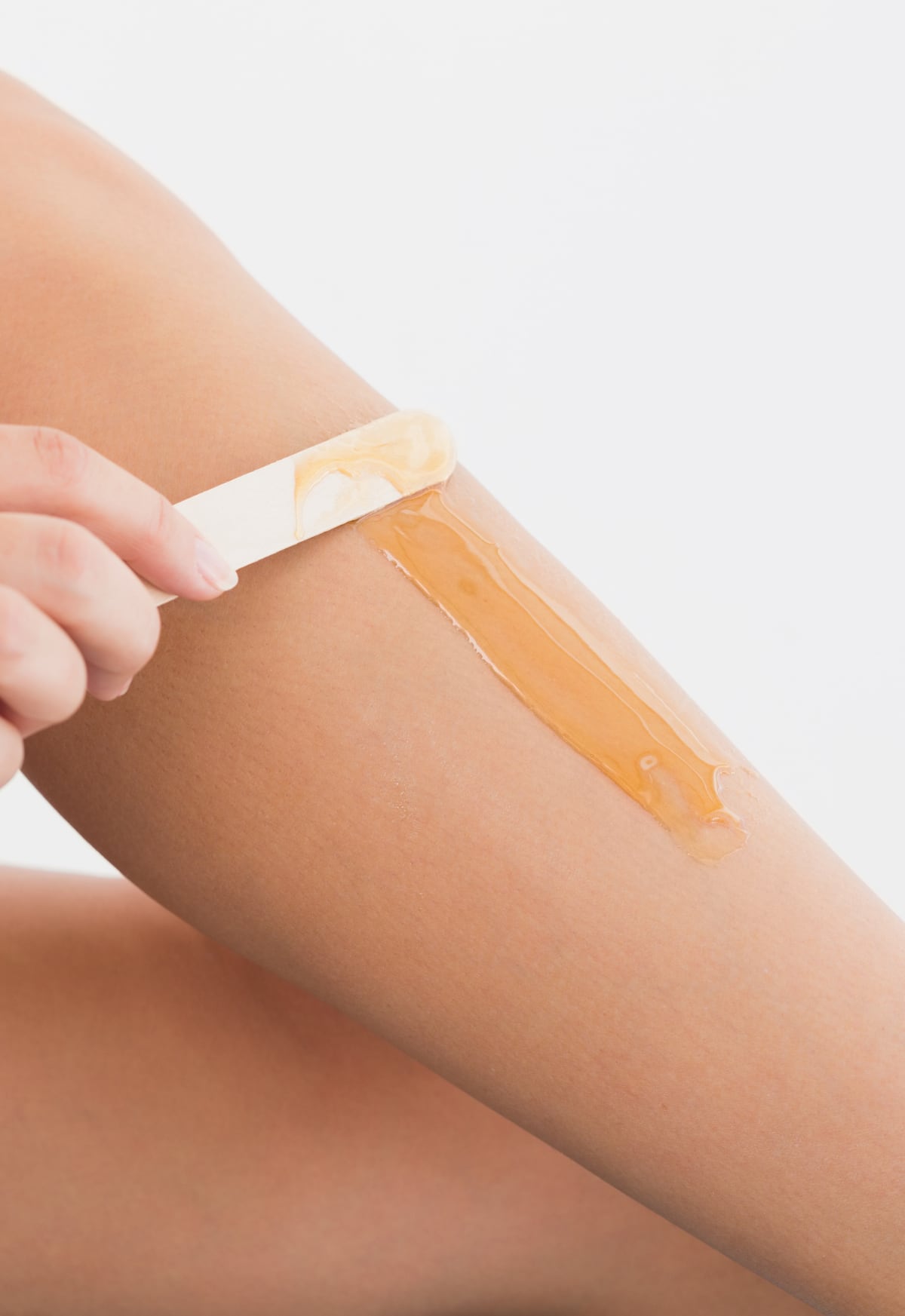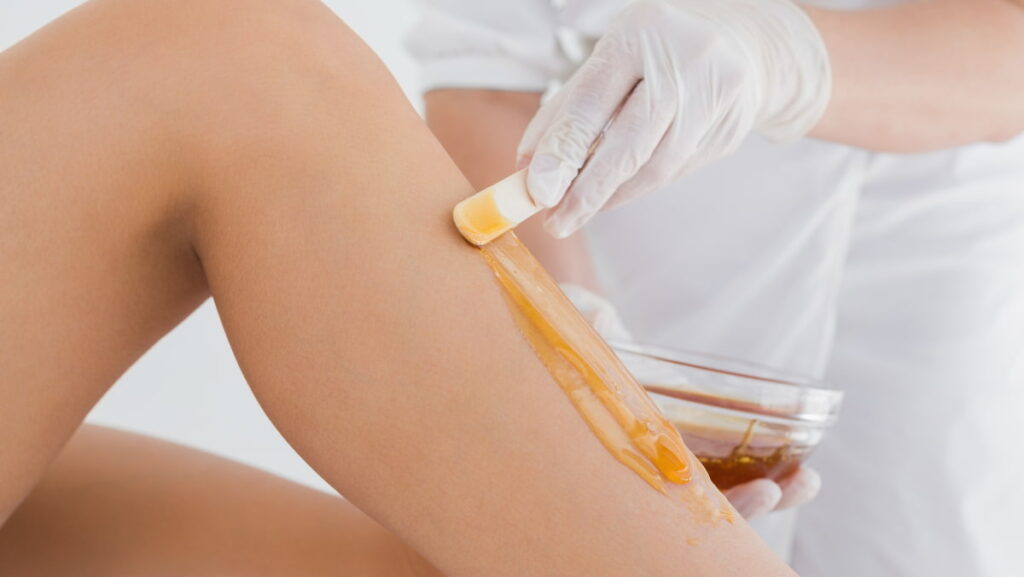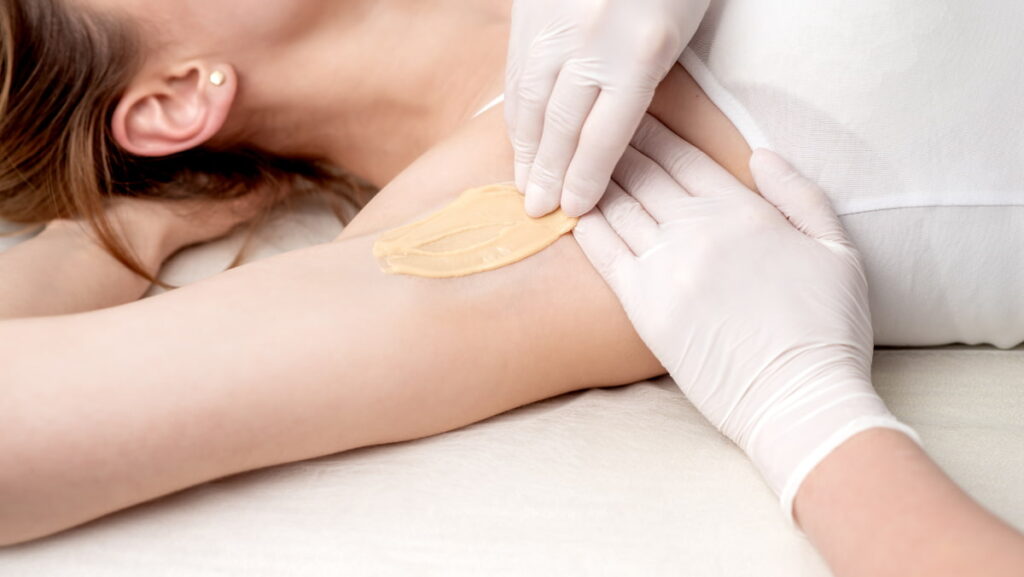
Nowadays, full body waxing has become quite a popular choice for many, mainly because we don’t really need to amount of hair like our ancestors did. Plus, nowadays, many people like to remove their body hair for aesthetics or other personal reasons.
If you’re new to this, you might wonder, “What is waxing exactly?” Waxing is a semi-permanent hair removal technique that removes hair from the root. Depending on your body’s cycle and genetics, the new hairs won’t grow back in the previously waxed area for two to eight weeks.
The process of body waxing might be a little bit more time-consuming compared to other methods like shaving or using depilatory cream. However, waxing provides a longer-lasting result. Who doesn’t want to get rid of their body hair for a few weeks?!
From the benefits of waxing and how to properly prepare for a session to aftercare tips and debunking common misconceptions, this guide will give you the knowledge you need to make an informed decision about whether full body waxing is the method for you.
What Is A Full Body Wax?
In short, full body waxing is a hair removal method in which you remove all—or close to all—hairs on your body using wax. For this hair removal technique, you need a special wax that adheres to your hair so that it rips out the hair from the root when the wax is removed. I know this sounds a little cruel, but… This is basically what waxing is.
Because waxing removes the hair from the root, it offers a deeper, more thorough hair removal solution than shaving, plucking, or using depilatory creams. These methods cut or dissolve the hair at the skin’s surface.
Here’s how it works: A thin layer of warm or cold wax is spread over the skin where unwanted hair grows. A cloth or paper strip is then pressed on top and ripped off with a quick movement against the direction of hair growth. Ouch! But hang in there; the more frequently you do it – the less painful it becomes.
Full Body Waxing Includes These Areas
Full body waxing basically covers a huge part of the body and is a great solution if you just want to have a hair-free body. Full body waxing isn’t just a service reserved for one gender; it’s available to everyone, and the process varies slightly depending on your needs. Generally, a full body wax includes:
Starting from the top, many full body waxing services offer eyebrow wax to frame your face just right. Moving down, some even include a upper lip wax and a chin wax to take care of any unwanted facial hair, making your skin as smooth as silk. Don’t forget the underarm wax, which is a godsend for those looking for long-lasting underarm hair removal.
Your full body wax package might also include a comprehensive arm waxing experience covering everything from your fingers to your shoulders, yes, even those pesky hairs on your wrist and elbow. And let’s not overlook the all-important back wax, aka the full back. Goodbye, unreachable back hair! As for the front? A stomach wax will have your abdomen looking flawless.
Legs – they’re a biggie. Full leg waxing typically includes everything from your toes (yes, toe hair is a thing) to your thighs. This often includes a detail-oriented approach to areas like the knees, ensuring even those hard-to-wax spots are smooth.
And now, the pièce de résistance: the intimate areas. For women, this typically means a bikini wax or Brazilian wax, while men might opt for a manzilian.
it’s good to remember that full body waxing is customizable. A reputable salon will tailor services to your needs, so if there’s an area you want to include or exclude, just talk to your esthetician. They’re there to make sure you walk out feeling great.
What Are the Pros And Cons Of Waxing

The Full Body Wax Benefits, Aka The Pros
You might wonder why you should choose full-body waxing over other methods like shaving or creams. Here’s a teaser: It can give you smoother skin, slower hair growth, and even exfoliation benefits! Intrigued?
Long-Lasting Results
Unlike shaving, which requires almost daily attention, waxing offers you freedom for weeks. Typically, you’re looking at about 3 to 6 weeks of serenity from hair worries.
This all had to do with the hair growth cycle. Waxing yanks out the hair from the root, meaning it’ll take a hot minute for it to surface again. This duration can vary based on your individual hair growth cycle, but the consensus is clear: waxing lets you enjoy longer stretches of smoothness.
Smooth Skin & Avoid Ingrown Hairs
By removing hair directly from the root, waxing leaves your skin feeling softer and looking more radiant than ever before. The best part? You’ll be saying goodbye to the irritation and bumps often caused by shaving.
Switch from shaving to waxing, and you’ll notice a significant reduction in ingrown hairs. Why? Unlike shaving (which merely trims at the surface), waxing removes hair right from the root, significantly decreasing the chances of getting those painful ingrowns.
Slows Down Hair Growth
Another benefit of removing hair at its root is that over time, your hair will grow back more slowly and softer than before! Forget about stubble sprouting up overnight; after a few sessions of full-body waxing, you’ll see an evident difference in both growth rate and texture!
Less Regrowth
With regular sessions over time, there’s less overall regrowth. Sounds amazing, right? That’s because it is! As your hair follicles get used to the waxing process, they’ll produce less and less hair. This means you’ll find yourself needing fewer appointments as time goes on—a real win-win situation!
In addition, waxing results in finer, softer regrowth. The hairs are pulled out from the root, and when they grow back, they’re less coarse. No more prickly stubble—just silky smooth skin that lasts! It’s time to bid goodbye to rough, irritating hair regrowth for good.
Can Reach Every Area
Full body waxes aren’t just limited to legs and arms—you can get as much or as little done as you’d like! This includes hard-to-reach areas like underarms or bikini lines where razors might not be effective. It’s especially beneficial for women who don’t want to shave their whole body every other day, for example.
Skincare Benefits
Think of full-body waxes as skincare treatments, too—they exfoliate by removing dead skin cells and unwanted hair! The result is that your pores are then open to receiving beneficial skincare treatments post-wax—the result? Unparalleled smoothness and a refreshed complexion!
Get Everything Hair-Free In One Go
Instead of scheduling separate appointments for your underarm wax, leg waxing, and bikini wax, you can tackle it all in one fell swoop. Many reputable salons offer full body wax packages, making them more time-efficient and often more financial-friendly than piecemeal services.
No Annoying Cuts, Razor Burn Or Nicks
One of the unsung heroes of waxing benefits has to be the freedom from cuts and nicks. With razors out of the equation, you can bid farewell to those pesky little injuries and the stinging that comes with accidentally nicking yourself. This is a significant win, especially in sensitive areas. Plus, without cuts, you also look at a reduced risk of skin infections or irritation.
What Are The Cons Of Waxing
We just talked about the significant pros of waxing. However, no method is perfect – so let’s talk about some potential downsides of waxing: Pain is often the first thing people think of when they hear ‘wax.’ While everyone has a different pain tolerance level, most agree that this method can be uncomfortable or even painful – especially for first-timers.
Finally, there are costs to consider too! Regular salon visits can add up quickly over time – making this method more expensive compared to alternatives like sugaring or shaving.
How Much Does A Full Body Wax Cost?
The full body wax price depends on the salon, the city, the type of wax used, and more. StyleSeat gathered data on this and found out that the average cost for a full body wax is around $150. The cost range is between $90 and $280.
What To Expect During A Full Body Waxing Session
If you book your waxing session, you are in the hands of a professional that knows what he/she is doing. They’ll ask you to undress, and often times disposable underwear or towels are provided for your comfort.
The next step is the actual application of the wax. The person who’s waxing you might explain to you what wax they’re using, what you can expect for that area, etc. The professional will then apply a thin layer of wax to the targeted area in the direction of hair growth. A cloth strip is pressed onto the wax and swiftly pulled off in the opposite direction of hair growth.
This method removes the hair from the root, ensuring a smooth and clean finish. The process is repeated until all desired areas are hair-free. I know this sounds painful, but I promise it is not as bad as it sounds!
The person waxing you will check in with you and ask how you’re doing—the person who waxed me even asked if I needed a little break. Before you know it, you’re done! You can then put on your clothes and plan a new appointment – if you want to.
Different Types Of Wax Used
Actually, there’s not just one type of wax. Nope, there are options! What type of wax is best for you depends on different things, such as skin type, hair type, and the area getting waxed. Some of the waxing options are:
- Soft Wax: Also known as strip wax, this type is commonly used for larger areas like the back, chest, and legs. The wax is applied thinly and removed with a cloth strip.
- Hard Wax: This wax is ideal for smaller, sensitive areas like the bikini line and underarms. It’s applied thickly and allowed to harden before being removed, so a cloth strip isn’t necessary.
- Sugar Wax: A natural alternative, sugar wax is made from sugar, lemon, and water. It’s gentle on the skin and a popular choice for people who have sensitive skin.
- Fruit Wax: Enriched with natural fruit extracts, this type of wax is gentle on the skin and offers a nice scent. It’s often used for facial waxing.
- Chocolate Wax: Chocolate wax is a type of hair removal wax that is made from natural ingredients such as cocoa, soybean oil, almond oil, glycerin, and vitamins. It is less painful than traditional wax hair removal and healthier than soft wax, as it is gentle on the skin and doesn’t leave any residue.
Here’s how these techniques stack up:
| Technique | Pain Level | Best For |
| Soft Wax | Moderate-High | Fine Hairs |
| Hard Wax | Low-Moderate | Sensitive Areas |
| Sugaring | Low | Natural Option |
| Fruit Wax | Low | Sensitive skin |
| Chocolate Wax | Low | Pain reduction |
Each type of wax has its unique benefits and suitability. The person who is waxing you knows what will work best for you and will recommend what he/she thinks you need.
While the waxing process is slightly uncomfortable, depending on the area, it is not as painful as some people paint it to be. Plus, it gives you a hair-free body for up to a few weeks (depending on your hair growth).

The Key Differences Between Sugaring VS Waxing
Sugaring is a form of waxing, but it is slightly different from normal wax. Don’t worry; let’s break down the key differences to help you make an informed decision.
First off, sugaring uses a paste made from natural ingredients such as sugar, lemon juice, and water. It’s applied at room temperature or slightly warmed. This means there’s less chance of burns compared to hot wax. Additionally, the paste sticks only to your hair – not your skin – reducing the pain during removal.
On the other hand, waxing involves applying a warm resin-based mixture onto your skin. Once it hardens, it’s swiftly removed along with the unwanted hair. While effective at removing even coarse hairs in one go, it can be harsher on sensitive skin types.
Here are some more differences:
- Application direction: For sugaring, you apply against the hair growth direction and remove it in its natural direction. This reduces breakage and ingrown hairs. However, waxing is quite the opposite; apply it in the direction of hair growth and rip it against.
- Skin health benefits: Sugaring has exfoliation benefits due to its natural components, like citric acid in lemon juice, which is known for brightening skin tone, while wax doesn’t offer this advantage.
- Cost-effectiveness: Typically, sugaring tends to cost more than waxing because of its organic ingredients, but remember, sometimes you get what you pay for!
The Key Differences Between Shaving VS. Waxing
Firstly, shaving — it’s like that quick fix, isn’t it? Grab your razor, some cream, and you’re good to go. Convenience is its middle name. But here’s the thing, it often feels like a never-ending cycle. The leg hair, underarm hair, you name it, they all seem to have a party and invite themselves back way too soon.
Not to mention skin irritation and those pesky cuts! It’s easy, yes, but temporary. Plus, let’s not forget the fuzz that feels like it’s growing back thicker and coarser each time. Annoying, right?
When you think about a full body wax, it includes everything—yes, even those intimate areas and yes, everything from eyebrows to toe. It might sound like a lot, but here’s the win—it significantly slows down the hair growth cycle. And when the hair grows back, it’s finer and sparser.
Skin irritation is way less of an issue here than with shaving, especially if your waxing expert uses high-quality accessories and wax suited for your skin type. Yes, it might pinch your pocket a bit more, but with full body wax packages, you can actually snag a deal that gives you more bang for your buck.
My Experience With A Full Body Wax
First up, my full body waxing included “only” a full leg wax and armpits. I get my brows waxed separately, which is included when I get a facial; otherwise, I would’ve opted for all areas to be waxed in one go.
I personally really like waxing. I have dark hair on my head and also on my body, so if I don’t shave very frequently, I get confronted with the correctness of the evolution theory—aka, I definitely look like a gorilla.
Is waxing painful? Well, yes, it’s not comfortable. However, it doesn’t hurt as much as I initially expected. It’s just a quick pain that’s over within seconds. I like waxing because it’s super convenient, but the long-lasting results are the best benefit of waxing.
Full body waxing may require a bit of courage and commitment initially, but the benefits you get in return make it well worth the effort, in my opinion!
If you’re like, “nah, full body waxing is not my thing!” after reading this post – I understand; it doesn’t sound fun to hurt yourself purposely haha. You may want to consider laser hair removal at home – check out my review of the JOVS Venus Pro II Hair Remover.
Frequently Asked Questions
How we reviewed this article
- Process
